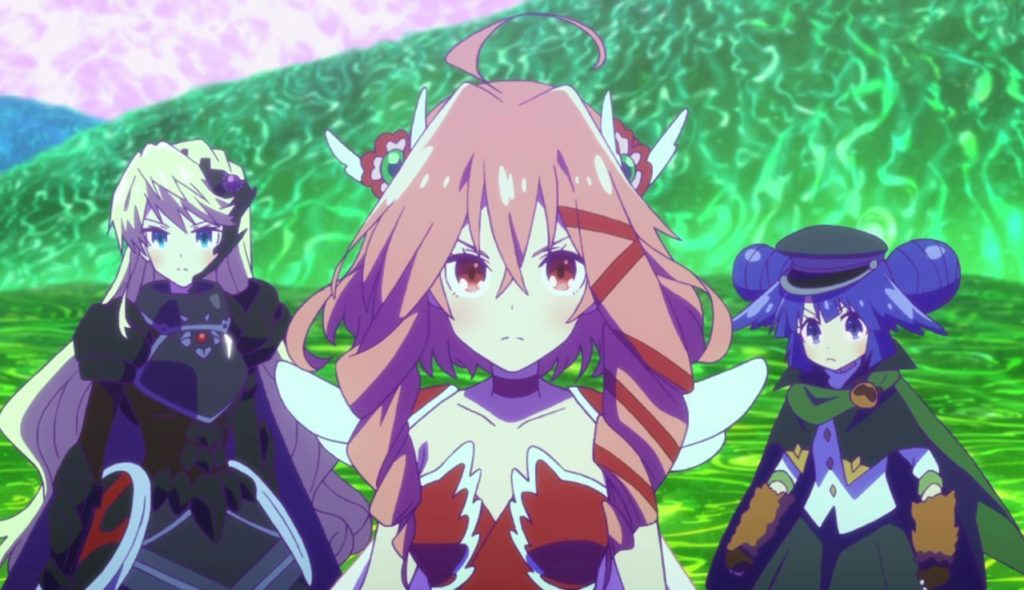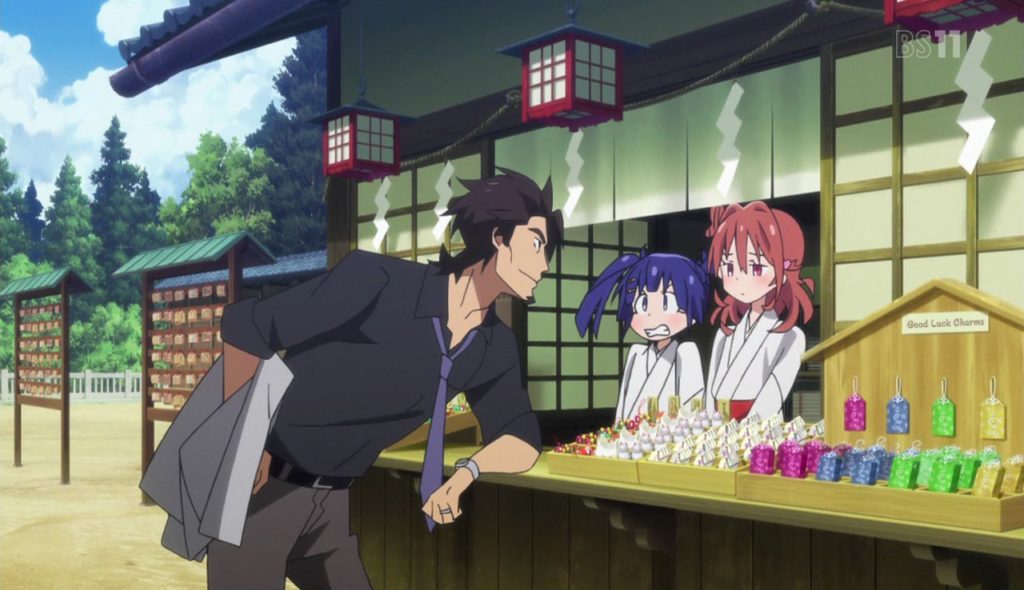Matoi the Sacred Slayer Complete Collection Review
The magical girl genre may not be over-saturated with content; not, at least in terms of what actually gets officially released outside of Japan. However it already has so many worldwide established works, it can be a very intimidating venture to create a new series for said genre, or make it memorable. We already have the ‘classic’ staples (Sailor Moon and Cardcaptor Sakura being the most notable examples), the ‘deconstructions’ (such as Princess Tutu and Madoka Magica) and even the gender swaps (Cute High Earth Defense Club LOVE comes to mind). So, to make a successful magical girl series, you have to do something that makes it stand out positively with something that has not been done before, and to be fair to Matoi the Sacred Slayer, it does make the best attempt it can.
We follow junior high shool girl Matoi Sumeragi, who works part-time at her best friend’s father’s shrine. During a normal working day, the shrine is attacked by an unknown man acting strangely and unable to speak. Realising he’s possessed by an evil spirit, Matoi’s friend Yuma performs a ritual of Divine Possession, which accidently summons a Higher Dimensional Being who forms a contract with Matoi and grants her powers. Whilst trying to keep her newfound powers a secret, several underground organisations arrive in town, as well as multiple demon possessions that start to interfere with Matoi’s attempts to live a quiet, normal life.

From the synopsis above, it doesn’t seem as if the series is anything out of the ordinary in the magical girl genre. Whilst the broad strokes are very familiar and unoriginal, it’s the details that make it a different blend of elements we’ve seen before. First of all: the magical girl aspect of the show is, in this universe, one and the same as Shrine Maidens who perform exorcisms. But exorcism as a concept is prevalent in other religions, such as Catholicism, which is also presented here. So, the anime portrays a unique blend of Japanese Shintoism and Western Christianity working alongside each other whilst having different philosophies and tactics for dealing with the villains of the show. This is presented from the big organisations such as IATO and Fatima fighting to be the first one on the scene and how their respective magical girls tackle combat situations. It’s a world building that doesn’t bog itself down with too much exposition but tries to give little titbits here and there to keep the audience invested. There’s also an inclusion of different dimensions; with us humans being in the third dimension but dealing with evil beings from upper dimensions, whilst also summoning powers from the same place, creates unique conflict and layers of battlegrounds, so the monster-of-the-week formula doesn’t become too repetitive because there’s always a higher dimension to uncover.
But the heart of the main plot (and where the writing is at its strongest) is the central character and her relationship with her father Shingo. The pair are somewhat estranged at the start because Shingo is a police officer with the usual long working and unsociable hours, but they are both still reeling from Matoi’s mother’s disappearance 10 years earlier. At the start, it seems that the pair are destined to remain apart emotionally, especially with Matoi’s new magical girl duties being an unwelcome addition to her life that she can’t share with others, plus in these type of shows the adults are often demoted to the background or even worse are faceless non-characters. However, as the series progresses, a lot of emotional development is depicted between the pair, and the father – whilst never quite elevated to main character – remains a recurring character that wants the best for his daughter. You can see how much his wife’s absence tears him up and how he wishes to communicate with Matoi more, and as they try to reconcile just before the final battle, the emotional turmoil and eventual pay-off feel real and well-earned.

Nevertheless, the emotional core of the story, and the aforementioned intrigue of all the different dimensions that the anime indulges in, only really come into their own in the second half of the story. Whilst there are hints and foreshadowings in the opening episodes, there are unfortunately a lot of writing fumbles and terrible fan service that can be very off-putting for the casual anime viewer, or those who don’t have the patience to see if a series bear fruit later on. Matoi the Sacred Slayer is not based on any visual novel or manga, it’s a completely new story, which sometimes can lead to some wonderful creations, Wolf’s Rain and Neon Genesis Evangelion for example. However, in a lot of cases if the series is being written as it’s animated, and if the writer is simply creating the story on the fly rather than have a carefully thought-out structure, it can lead to some very messy results that fail to tie up all the loose ends, just like Angel Beats or Martian Successor Nadesico. Matoi the Sacred Slayer sadly belongs in the latter category. For example: the secret organisations each have one representative: Luciela from IATO and Cariot from Fatima respectively, and they act incredibly shadily across the series, hinting that they know a lot more than we’ve been told. However, this all goes nowhere. Outside of the opening episode and one random scene ,as we head towards the climax we don’t learn any more about either organisation, what they want or how they operate; the ‘shadiness’ of their characters never changes or develops even as the final battle draws nearer. They remain flat for the entire duration of the anime, and it gets worse as we are introduced to the numerous Japanese shrines that seem to have their own magical/exorcist girls at hand, begging the questions as to why the organisations are there in the first place.
The structure of the series is also weirdly paced; the opening episodes seem to be building towards a single evil spirit (or Nights) as the ‘big bad’ but he’s then unceremoniously killed off as soon as he’s introduced. Afterwards it’s all forgotten about and moves on to a new story entirely. It also doesn’t help that the tone of the opening episodes, which relies heavily on the running gag of junior high school girls running around naked in town due to lacking clothing after transformation, and even one gag where the father Shingo ends up groping his own daughter (context doesn’t matter, it still happens unfortunately) is drastically different to the rest of the series. It all reeks of a writing team that didn’t have a full structure of the plot mapped out before the series was green-lit; thankfully the end is satisfying, but the opening episodes are a struggle to get through, and may not be worth it for some viewers.
The DVD version of this series was provided for review, however, based upon the animation quality being below sub-par, I cannot really recommend the Blu-ray. The ‘moe’ look is prominent here which often provokes a mixed reaction in the West, but the character models are often rubbery and flat. White Fox do make more of an effort to make the battles as colourful and fun as possible, but cut corners whenever they can. It’s also a shame that they didn’t even bother to give the girls a proper ‘magical girl’ transformation; one of the staples of the genre!
MVM have released this anime on DVD and Blu-ray; both contain clean opening/closing, Japanese commericals and promos, Sentai Filmwork trailers, and on the last disc you’ll find the TV special episode where the entirety of the series is retold over a single episode (should you need a refresher) and the OVA ‘Nightbusters Corporation’, which is an affection parody of the idol industry with a few references to Ghostbusters, that takes place after the series’s finale. It should be noted however that this is a sub-only release.
Matoi the Sacred Slayer stumbles a few times in the opening episodes and doesn’t entirely recover from it, however the latter half provides a heart-warming and fun ride for those who are willing to stay long enough to ride it out. If you’re a massive consumer of all things Magical Girl then Matoi may be a nice distraction; for others, there are plenty of other series in the genre that deserve your money and time spent with it.



